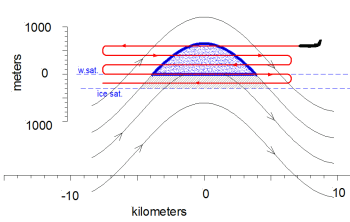ICE-L
Ice in Clouds Experiment (ICE-L)
The Ice in Clouds Experiment: More than 50% of the earth's precipitation originates in the ice phase. Ice nucleation, therefore, is one of the most basic processes that lead to precipitation. The poorly understood processes of ice initiation and secondary ice multiplication in clouds result in large uncertainties in the ability to model precipitation production and to predict climate changes. Therefore, progress in modeling precipitation accurately requires a better understanding of ice formation processes.
Scientific Goals
Recent advances in observational tools, laboratory cloud simulation chambers, numerical models, and computer hardware are providing new capabilities to understand and model ice initiation processes. The objective of the Ice in Clouds Experiment (ICE) is to focus on the following long term scientific goal:
To show that under given conditions, direct ice nucleation measurement(s), or other specific measurable characteristics of the aerosol, can be used to predict the number of ice particles forming by nucleation mechanisms in selected clouds. We also seek improved quantitative understanding of the roles of thermodynamic pathway, location within the cloud, and temporal dependency.
Observational Thrusts
The first step in this project is to seek cases with a strong aerosol-ice nucleation signal. It will focus on observational studies with high likelihood of showing a strong connection of aerosols to effect ice formation. These cases occur in geographic areas that experience alternatively dust events and dust-free background. The targets are layer clouds: lenticular wave clouds, nimbostratus, and extensive altocumulus and altostratus decks. The thermodynamic and kinematic environments of lenticular wave clouds are relatively steady with lifetimes often longer than an hour, making these clouds an attractive target for study. Wave clouds provide a range of temperature, humidity, and vertical wind conditions in which first ice may form in a laboratory-like setting. Some of the conditions observed in wave clouds can be approximated in laboratory cloud chamber experiments for ice formation studies and for characterizing the performance of airborne ice nuclei instruments.
Field Study in 2007
In 2007, ICE focused on airborne measurements of clouds, concentrating on the role of heterogeneous nucleation, along with coordinating ground measurements in mountainous locations such as the Front Range of Colorado and Wyoming. Close collaboration between theory, field, lab, and modeling studies will be emphasized through involvement of participants who specialize in these different approaches.
All photos copyright University Corporation for Atmospheric Research unless otherwise noted.
Principal Investigators:
- A. Heymsfield NCAR/MMM
- J. Stith NCAR/EOL/RAF
- D. Rogers NCAR/EOL
Project Manager:
- Jorgen Jensen NCAR/EOL/RAF
Data Manager:
- EOL Archive NCAR/EOL/DMS
